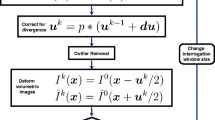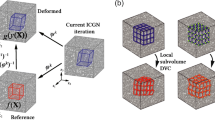Abstract
We develop speed and efficiency improvements to a three-dimensional (3D) digital volume correlation (DVC) algorithm, which measures displacement and strain fields throughout the interior of a material. Our goal is to perform DVC with resolution comparable to that achieved in 2D digital image correlation, in time that is commensurate with the image acquisition time. This would represent a significant improvement over the current state-of-the-art available in the literature. Using an X-ray micro-CT scanner, we can resolve features at the 5 micron scale, generating 3D images with up to 36 billion voxels. We compute twelve degrees-of-freedom at each correlation point and utilize tricubic spline interpolation to achieve high accuracy. We improve the algorithm’s speed and robustness through an improved coarse search, efficient implementation of spline interpolation, and using smoothing splines to address noisy image data. For DVC, the volume of data, number of correlation points, and work to solve each correlation point grow cubically. We therefore employ parallel computing to handle this tremendous increase in computational and memory requirements. We demonstrate the application of DVC using simulated deformations of 3D micro-CT scans of polymer samples with embedded particles forming an internal pattern.












Similar content being viewed by others
References
Efstathiou C, Sehitoglu H, Lambros J (2010) Multiscale strain measurements of plastically deforming polycrystalline titanium: Role of deformation heterogeneities. Int J Plast 26:93–106
Liu C (2005) On the minimum size of representative volume element: An experimental investigation. Exp Mech 45(3):238–243
Moulart R, Rotinat R, Pierron F (2009) Full-field evaluation of the onset of microplasticity in a steel specimen. Mech Mater 41:1207–1222
Bay BK, Smith TS, Fyhrie DP, Saad M (1999) Digital volume correlation: three-dimensional strain mapping using X-ray tomography. Exp Mech 39:217–226
Liu L, Morgan EF (2007) Accuracy and precision of digital volume correlation in quantifying displacements and strains in trabecular bone. J Biomech 40:3516–3520
Smith TS, Bay BK, Rashid MM (2002) Digital volume correlation including rotational degrees of freedom during minimization. Exp Mech 42:272–278
Zauel R, Yeni YN, Bay BK, Dong XN, Fyhrie DP (2006) Comparison of the linear finite element prediction of deformation and strain of human cancellous bone to 3D digital volume correlation measurements. J Biomech Eng 128:1–6
Lenoir N, Bornert M, Desrues J, Bésuelle P, Viggiani G (2007) Volumetric digital image correlation applied to X-ray microtomography images from triaxial compression tests on argillaceous rock. Strain 43:193–205
Roux S, Hild F, Viot P, Bernard D (2008) Three-dimensional image correlation from X-ray computed tomography of solid foam. Composites: Part A 39:1253–1265
Forsberg F, Sjödahl M, Mooser R, Hack E, Wyss P (2010) Full three-dimensional strain measurements on wood exposed to three-point bending: analysis by use of digital volume correlation applied to synchrotron radiation micro-computed tomography image data. Strain 46:47–60
Forsberg F, Siviour CR (2009) 3D deformation and strain analysis in compacted sugar using X-ray microtomography and digital volume correlation. Meas Sci Technol 20:1–8
Hall SA, Bornert M, Desrues J, Pannier Y, Lenoir N, Viggiani G, Besuelle P (2010) Discrete and continuum analysis of localised deformation in sand using X-ray μCT and volumetric digital image correlation. Geotechnique 60(5):315–322
Rannou J, Limodin N, Réthoré J, Gravouil A, Ludwig W, Baïetto-Dubourg MC, Buffière JY, Combescure A, Hild F, Roux S (2010) Three dimensional experimental and numerical multiscale analysis of a fatigue crack. Comput Methods Appl Mech Eng 199:1307–1325
Carroll J, Efstathiou C, Lambros J, Sehitoglu H, Hauber B, Spottswood S, Chona R (2009) Investigation of fatigue crack closure using multiscale image correlation experiments. Eng Fract Mech 76:2384–2398
Franck C, Hong S, Maskarinec S, Tirrell D, Ravichandran G (2007) Three-dimensional full-field measurements of large deformations in soft materials using confocal microscopy and digital volume correlation. Exp Mech 47:427–438
Germaneau A, Doumalin P, Dupré JC (2007) 3D strain field measurement by correlation of volume images using scattered light: recording of images and choice of marks. Strain 43:207–218
Haldrup K, Nielsen S, Mishnaevsky Jr L, Beckman F, Wert J (2006) 3-dimensional strain fields from tomographic measurements. In: Proceedings of SPIE 6318, 63,181B
Verhulp E, van Rietbergen B, Huiskes R (2004) A three-dimensional digital image correlation technique for strain measurements in microstructures. J Biomech 37:1313–1320
Limodin N, Réthoré J, Adrien J, Buffière JY, Hild F, Roux S (2010) Analysis and artifact correction for volume correlation measurements using tomographic images from a laboratory x-ray source. Exp Mech. doi:10.1007/s11340-010-9397-4
Hild F, Maire E, Roux S, Witz JF (2009) Three-dimensional analysis of a compression test on stone wool. Acta Mater 57:3310–3320
Kobayashi M, Toda H, Kawai Y, Ohgaki T, Uesugi K, Wilkinson DS, Kobayashi T, Aoki Y, Nakazawa M (2008) High-density three-dimensional mapping of internal strain by tracking microstructural features. Acta Mater 56:2167–2181
Bruck H, McNeill S, Sutton M, Peters III W (1989) Digital image correlation using Newton–Raphson method of partial differential correction. Exp Mech 29:261–267
Schreier HW, Braasch JR, Sutton MA (2000) Systematic errors in digital image correlation caused by intensity interpolation. Opt Eng 39:2915–2921
MathWorks, Inc (2009) MATLAB. Natick, MA
Chu T, Ranson W, Sutton M, Peters W (1985) Applications of digital-image-correlation techniques to experimental mechanics. Exp Mech 25:232–244
Schoenberg IJ (1946) Contributions to the problem of approximation of equidistant data by analytic functions. Q Appl Math 4:45–99
Dierckx P (1993) Curve and surface fitting with splines. Oxford University Press
de Boor C (1978) A practical guide to splines. Springer-Verlag
Buis PE, Dyksen WR (1996) Efficient vector and parallel manipulation of tensor products. ACM Trans Math Softw 22(1):18–23
McCalpin JD (1995) Memory bandwidth and machine balance in current high performance computers. IEEE Computer Society Technical Committee on Computer Architecture (TCCA) Newsletter
Bartels RH, Beatty JC, Barsky BA (1995) An introduction to splines for use in computer graphics and geometric modeling. Morgan Kaufmann
Anderson E et al (1999) LAPACK users’ guide, 3rd edn. SIAM
Reinsch CH (1967) Smoothing by spline functions. Numer Math 10:177–183
MPI Forum (2009) MPI: a message-passing interface standard. http://www.mpi-forum.org/
Goodier JN (1933) Concentration of stress around spherical and cylindrical inclusions and flaws. J Appl Mech 55(7):39–44
Lötters JC, Olthuis W, Veltink PH, Bergveld P (1997) The mechanical properties of the rubber elastic polymer polydimethylsiloxane for sensor applications. J Micromechanics Microengineering 7:145–147
Acknowledgements
We are grateful to Charles Mark Bee and the Imaging Technology Group at the Beckman Institute for the use of the Skyscan MicroCT scanner, Prof. Nancy Sottos and Brett Beiermann of the Autonomic Materials Research Group at the Beckman Institute for help in preparing PDMS samples, and Prof. Michael Sutton for helpful discussions. We gratefully acknowledge the use of the Turing cluster maintained and operated by the Computational Science and Engineering Program at the University of Illinois. This work was supported by the Center for Simulation of Advanced Rockets under contract number B523819 funded by the U.S. Department of Energy, by the Institute for Advanced Computing Applications and Technologies, and by award number 09084 from the University of Illinois Campus Research Board.
Author information
Authors and Affiliations
Corresponding author
Rights and permissions
About this article
Cite this article
Gates, M., Lambros, J. & Heath, M.T. Towards High Performance Digital Volume Correlation. Exp Mech 51, 491–507 (2011). https://doi.org/10.1007/s11340-010-9445-0
Received:
Accepted:
Published:
Issue Date:
DOI: https://doi.org/10.1007/s11340-010-9445-0




